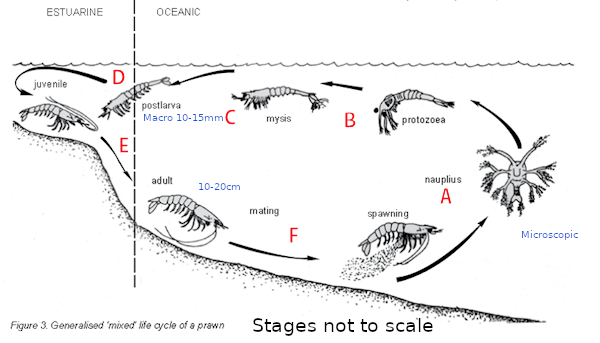


Prawn Life Cycle
Recently (2014) the University of New South Wales developed a plan to boost the stocks of King Prawns in Lake Tyers by releasing 300,000 post larval prawns (about 10 mm long at that stage, and look like miniature prawns) into the lake. Residents around the Lakes Entrance and Lake Tyers take a great interest in the prawns as they are both delectable eating and also excellent fish bait.However the life cycle of the Prawns found in our lakes is much more of a mystery and does make interesting reading. An excellent document is produced by the NSW DPI called Biology and life cycles of prawns
This document is the source of the information below.

Above is a diagram of a generalised Prawn life cycle and should whet your appetite to look up the original document as each stage is well described in layman's terms and is quoted below.
A. The ‘mixed’ life cycle is picked up at this point here, where spawning has occurred and fertilized eggs are shed onto the bottom in oceanic waters where they remain for a short period until they hatch. The first larval stage called a nauplius emerges from the spherical egg and starts swimming up towards the surface. This naupliar stage goes through several moults, getting larger with each moult, and ultimately changes to a protozoea. |
B.
The prawn similarly moults and grows through several protozoea
then mysis stages before developing into a postlarva.
The mysis stage is the first stage that somewhat resembles the
appearance of the adult prawn. The development time from
spawning to postlarva for prawn species with ‘estuarine’ or
‘mixed’ life cycles is between two and three weeks. Hatching
success and larval survival are affected by water temperature
and salinity and are greatest in waters of the same temperature
and salinity as that where spawning took place. |
C. Up to the mysis stage the larvae are free swimming and form part of the zooplankton found in the open sea. Zooplankton together with phyto-plankton is eaten by a multitude of other animals, including larval prawns, and is a vital part of the ocean’s food system. |
D. After the free swimming, planktonic mysis stage, postlarva adopt a bottom existence, reach the shore and enter the rivers and coastal lakes In the estuaries and lakes, the juvenile prawns have to adapt to wide fluctuations in, among other things, salinity and temperature. School prawns appear to be more tolerant of these fluctuations than eastern king prawns. |
| E. After
over-wintering in the estuaries and lakes the juvenile
prawns grow rapidly and upon some cue, start to
migrate back to the ocean. These migrations rise to a peak in
the ‘dark’ period of the summer, lunar cycles and are fished
enthusiastically by both amateur and professional fishermen. |
.
Chris Setio, Dr James Smith and Tim Bull MLA releasing the very
last bag of prawns at stage D. |
| F. The
physiology of prawns with a ‘mixed’ life cycle is such that the
prawns require the conditions found in the deeper ocean waters
to reach maturity. Once they reach oceanic waters, the prawns rapidly mature, mate and spawn – thus completing the life cycle. |
G. The
life cycle of prawns is rather short with species such as school
prawns living, for the most part, a little over a
year while larger species such as eastern king prawns
are probably up to two years old, with some individuals perhaps
entering a third year of life. For more information on the East Australian Current |